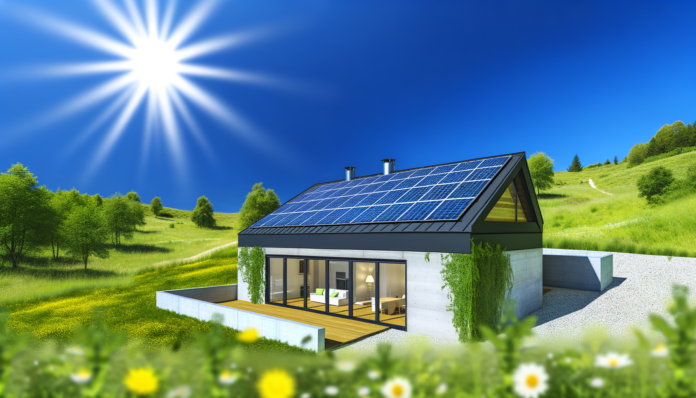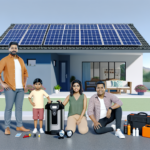Introduction
Overview of Off-Grid Living
Off-grid living is a lifestyle choice that involves disconnecting from the traditional utility grid and becoming self-sufficient in terms of energy, water, and other essential resources. This way of life is gaining popularity as people seek to reduce their environmental impact, achieve financial independence, and embrace a simpler, more sustainable existence. Off-grid living can take many forms, from remote cabins in the wilderness to modern homes equipped with advanced technology. The common thread is a commitment to self-reliance and a desire to live in harmony with nature.
Importance of Solar Power in Off-Grid Living
Solar power plays a crucial role in off-grid living, providing a reliable and renewable source of energy. Unlike traditional fossil fuels, solar energy is abundant, sustainable, and environmentally friendly. By harnessing the power of the sun, off-grid dwellers can generate electricity to power their homes, charge batteries, and run essential appliances. Solar panels, combined with energy storage systems, allow individuals to maintain a consistent power supply even in remote locations. This not only reduces dependence on external energy sources but also minimizes the carbon footprint, contributing to a healthier planet.
Purpose of the Article
The purpose of this article is to inspire and inform readers about the possibilities and benefits of off-grid solar living. Through a series of compelling stories, we will showcase the triumphs and challenges faced by individuals and communities who have embraced this lifestyle. By highlighting their journeys, we aim to provide practical insights, valuable tips, and a sense of empowerment for those considering a transition to off-grid solar living. Whether you are motivated by environmental concerns, financial savings, or a desire for greater independence, this article will offer a comprehensive guide to help you navigate the path to a sustainable, off-grid future.
The Appeal of Off-Grid Solar Living
Environmental Benefits
Living off-grid with solar power offers significant environmental advantages. By harnessing the sun’s energy, individuals can reduce their reliance on fossil fuels, thereby decreasing their carbon footprint. Solar power is a clean, renewable energy source that does not emit greenhouse gases or other pollutants. This shift towards sustainable energy helps combat climate change and promotes a healthier planet. Additionally, off-grid living often involves adopting other eco-friendly practices, such as rainwater harvesting, composting, and organic farming, further enhancing the environmental benefits.
Financial Savings
One of the most compelling reasons to transition to off-grid solar living is the potential for substantial financial savings. While the initial setup costs for solar panels and related equipment can be high, the long-term savings on utility bills are significant. Once the system is in place, the energy generated from the sun is free, leading to reduced or even eliminated electricity costs. Over time, the investment in solar technology pays for itself, making it a financially savvy choice. Moreover, many regions offer incentives, tax credits, and rebates for installing solar systems, further offsetting the initial expenses.
Independence and Self-Sufficiency
Off-grid solar living provides a sense of independence and self-sufficiency that is highly appealing to many. By generating their own power, individuals are no longer reliant on public utilities and are less vulnerable to power outages and price hikes. This autonomy extends beyond energy to other aspects of life, such as water supply and food production. Many off-grid enthusiasts grow their own food and collect rainwater, creating a self-sustaining lifestyle. This level of independence fosters a deeper connection to the environment and a greater appreciation for natural resources.
Adventure and Lifestyle
For those with a spirit of adventure, off-grid solar living offers a unique and fulfilling lifestyle. It encourages a simpler, more intentional way of living, often in remote and beautiful locations. The challenges and rewards of building and maintaining an off-grid home can be incredibly satisfying. This lifestyle attracts individuals who value freedom, creativity, and a closer connection to nature. Whether it’s a family building a sustainable homestead, an adventurer exploring the wilderness, or a solo traveler seeking solitude, off-grid solar living provides a diverse range of experiences that enrich one’s life.
In summary, the appeal of off-grid solar living lies in its environmental benefits, financial savings, independence, and the adventurous lifestyle it offers. This way of life not only promotes sustainability but also empowers individuals to take control of their energy needs and live more harmoniously with the planet.
Inspiring Stories of Off-Grid Solar Triumphs
Story 1: A Family’s Journey to Sustainability
The Johnson family decided to leave behind their suburban lifestyle and embrace a more sustainable way of living. They purchased a plot of land in rural Oregon and built their dream home, powered entirely by solar energy. The transition wasn’t easy; it required significant planning and investment. However, the family was committed to reducing their carbon footprint and living in harmony with nature. Today, their home is a model of sustainability, featuring solar panels, a rainwater collection system, and a vegetable garden that provides most of their food. The Johnsons have not only reduced their utility bills but also taught their children the importance of environmental stewardship.
Story 2: An Adventurer’s Solar-Powered Expedition
Meet Sarah, an avid adventurer who decided to take her love for the outdoors to the next level. She embarked on a year-long expedition across North America in a solar-powered camper van. Equipped with solar panels and a battery storage system, her van allowed her to travel to remote locations without worrying about finding a power source. Sarah’s journey was not just about exploring new places; it was also about proving that sustainable travel is possible. Along the way, she documented her experiences, sharing tips on how to live off-grid and minimize environmental impact. Her story has inspired many to consider more eco-friendly ways of traveling.
Story 3: A Community’s Transition to Solar Power
In a small village in New Mexico, the residents decided to take collective action to reduce their dependence on fossil fuels. Led by architect Michael Reynolds, the community built a series of Earthships—sustainable homes made from recycled materials like tires and bottles. These homes are designed to be self-sufficient, utilizing solar and wind power for electricity. The transition wasn’t without challenges; they faced bureaucratic hurdles and skepticism from local authorities. However, their determination paid off. Today, the village is a thriving example of what can be achieved when a community comes together with a shared vision for sustainability.
Story 4: A Solo Traveler’s Off-Grid Experience
Vanna White spent over a year living on the road in a converted Sprinter camper van. Her journey was not just a physical one but also an emotional and spiritual exploration. Equipped with solar panels, her van allowed her to live off-grid, providing her with the freedom to travel wherever she wanted. The experience taught her valuable lessons about self-sufficiency and the importance of slowing down to enjoy life. Although her journey ended with the dissolution of her relationship, Vanna emerged with a renewed sense of purpose and a commitment to building a life that aligns with her values. Her story serves as a powerful reminder that living off-grid can be a transformative experience.
Challenges and Solutions in Off-Grid Solar Living
Initial Setup and Costs
Setting up an off-grid solar system can be a significant financial investment. The initial costs include purchasing solar panels, batteries, inverters, and other necessary equipment. Additionally, there may be expenses related to installation and labor. For many, this upfront cost can be a barrier to transitioning to off-grid solar living. However, there are solutions to mitigate these costs:
- Grants and Subsidies: Various government programs and non-profit organizations offer grants and subsidies to help offset the initial costs of solar installations.
- Financing Options: Many companies provide financing plans that allow homeowners to pay for their solar systems over time, making it more affordable.
- DIY Installations: For those with technical skills, opting for a DIY installation can significantly reduce labor costs.
Maintenance and Upkeep
Maintaining an off-grid solar system requires regular attention to ensure it operates efficiently. This includes cleaning the solar panels, checking battery health, and monitoring the system’s overall performance. Neglecting maintenance can lead to reduced efficiency and potential system failures. Here are some solutions to address maintenance challenges:
- Regular Inspections: Schedule regular inspections to identify and address any issues before they become major problems.
- Professional Services: Hiring professionals for periodic maintenance can ensure that the system remains in optimal condition.
- Monitoring Systems: Invest in monitoring systems that provide real-time data on the performance of the solar setup, allowing for timely interventions.
Weather and Environmental Factors
Weather conditions and environmental factors can significantly impact the efficiency of an off-grid solar system. Cloudy days, heavy snowfall, and extreme temperatures can reduce the amount of energy generated. Additionally, environmental factors like dust and debris can accumulate on solar panels, further decreasing their efficiency. Solutions to these challenges include:
- Energy Storage: Investing in high-capacity batteries can store excess energy generated on sunny days for use during periods of low sunlight.
- Panel Positioning: Properly positioning solar panels to maximize exposure to sunlight can help mitigate the effects of adverse weather conditions.
- Regular Cleaning: Implement a routine cleaning schedule to keep solar panels free from dust and debris.
Technological Advancements and Innovations
The field of off-grid solar technology is continually evolving, with new advancements and innovations making systems more efficient and affordable. However, keeping up with these technological changes can be challenging. Some solutions to stay updated include:
- Continuous Learning: Stay informed about the latest developments in solar technology through online courses, webinars, and industry publications.
- Upgradable Systems: Invest in modular systems that can be easily upgraded as new technologies become available.
- Professional Advice: Consult with solar energy professionals to understand the best options for incorporating new technologies into existing systems.
By addressing these challenges with practical solutions, individuals and communities can successfully transition to and maintain off-grid solar living, reaping the benefits of independence, sustainability, and financial savings.
Practical Tips for Transitioning to Off-Grid Solar Living
Assessing Your Energy Needs
Before diving into off-grid solar living, it’s crucial to understand your energy requirements. Start by listing all the electrical devices you plan to use, including lights, appliances, and gadgets. Calculate the total wattage and estimate the daily usage in hours. This will help you determine the size of the solar system you need. Remember, it’s always better to overestimate your energy needs to ensure you have enough power, even on cloudy days.
Choosing the Right Solar Equipment
Selecting the appropriate solar equipment is vital for a successful transition. Here are the key components you’ll need:
- Solar Panels: Choose high-efficiency panels that can generate sufficient power based on your energy assessment.
- Inverter: This device converts the DC power generated by the panels into AC power for your household appliances.
- Batteries: Opt for deep-cycle batteries that can store energy for use during nighttime or cloudy days.
- Charge Controller: This regulates the voltage and current coming from the solar panels to prevent battery overcharging.
Consider consulting with a solar expert to ensure you select the right equipment tailored to your specific needs.
Installation and Setup
Proper installation is key to maximizing the efficiency of your solar system. Here are some steps to follow:
- Site Assessment: Choose a location with maximum sun exposure, typically a south-facing roof or an open yard.
- Mounting the Panels: Secure the panels on a sturdy mount, ensuring they are angled correctly to capture the most sunlight.
- Connecting the System: Follow the manufacturer’s instructions to connect the panels to the inverter, batteries, and charge controller.
- Testing: Once everything is connected, test the system to ensure it’s working correctly and efficiently.
If you’re not comfortable with DIY installation, consider hiring a professional to ensure everything is set up safely and correctly.
Maintenance and Troubleshooting
Maintaining your off-grid solar system is essential for long-term success. Here are some tips:
- Regular Inspections: Check your panels, batteries, and connections periodically for any signs of wear or damage.
- Cleaning: Keep your solar panels clean and free of debris to ensure maximum efficiency.
- Battery Care: Monitor battery levels and ensure they are not overcharged or completely drained.
- Troubleshooting: Familiarize yourself with common issues, such as inverter faults or battery problems, and know how to address them.
By staying proactive with maintenance, you can ensure your off-grid solar system remains reliable and efficient for years to come.
Future Trends in Off-Grid Solar Technology
Emerging Technologies
The off-grid solar sector is witnessing a surge in technological advancements that promise to revolutionize how we harness and utilize solar energy. One of the most exciting developments is the advent of **bifacial solar panels**, which can capture sunlight from both sides, significantly increasing energy yield. These panels are particularly effective in areas with high albedo surfaces, such as snow or sand, which reflect sunlight back onto the panels.
Another groundbreaking innovation is the integration of **solar tracking systems**. These systems adjust the angle of the solar panels throughout the day to follow the sun’s trajectory, maximizing energy capture. Coupled with advancements in **energy storage solutions** like lithium-ion and solid-state batteries, these technologies ensure that solar energy can be stored efficiently and used during periods of low sunlight or at night.
Sustainability and Eco-Friendly Innovations
Sustainability is at the core of off-grid solar technology advancements. Innovations are not just focused on improving efficiency but also on reducing the environmental impact of solar systems. **Recyclable solar panels** are becoming more prevalent, designed to minimize waste and make the end-of-life disposal process more eco-friendly. These panels use materials that can be easily separated and recycled, reducing the environmental footprint.
Moreover, the development of **organic photovoltaic cells (OPVs)** is gaining traction. These cells use organic molecules to capture sunlight, offering a more sustainable alternative to traditional silicon-based panels. OPVs are lightweight, flexible, and can be produced using less energy-intensive processes, making them an attractive option for sustainable solar solutions.
Predictions for the Next Decade
Looking ahead, the next decade promises to be transformative for off-grid solar technology. **Artificial Intelligence (AI)** and **machine learning** will play a crucial role in optimizing solar energy systems. AI can predict energy consumption patterns, weather conditions, and system performance, allowing for more efficient energy management and reducing waste.
The integration of **Internet of Things (IoT)** devices will further enhance the functionality of off-grid solar systems. IoT-enabled sensors can monitor the performance of solar panels and batteries in real-time, providing valuable data for maintenance and optimization. This will lead to more reliable and efficient solar energy systems, reducing downtime and maintenance costs.
Additionally, the concept of **solar microgrids** is expected to gain momentum. These localized grids can operate independently or in conjunction with the main grid, providing a reliable energy source for remote communities. Microgrids can be tailored to specific energy needs and are particularly useful in disaster-prone areas where traditional power infrastructure is vulnerable.
In conclusion, the future of off-grid solar technology is bright, with numerous innovations on the horizon that promise to make solar energy more efficient, sustainable, and accessible. As these technologies continue to evolve, they will play a pivotal role in driving the global transition to renewable energy and achieving energy independence for off-grid communities.
Conclusion
Recap of Key Points
As we journeyed through the inspiring world of off-grid solar living, we explored the multifaceted appeal of this lifestyle. From the environmental benefits and financial savings to the independence and adventure it offers, off-grid solar living presents a compelling case for those seeking a sustainable and self-sufficient way of life. We delved into the heartwarming stories of individuals and communities who have successfully transitioned to off-grid solar living, showcasing their triumphs and the transformative impact of solar power. Additionally, we addressed the challenges faced in this journey and provided practical solutions and tips for those considering making the switch. Finally, we looked ahead to the future trends in off-grid solar technology, highlighting emerging innovations and sustainability efforts.
Encouragement to Explore Off-Grid Solar Living
The stories and insights shared in this article are a testament to the incredible potential of off-grid solar living. Whether you are motivated by environmental concerns, financial savings, or the desire for a more independent lifestyle, the transition to off-grid solar living is a viable and rewarding path. The experiences of those who have already made this transition serve as a source of inspiration and a reminder that with determination and the right resources, anyone can achieve this dream. We encourage you to explore the possibilities of off-grid solar living, assess your energy needs, and take the first steps towards a more sustainable and self-sufficient future.
Final Thoughts
Living off the grid with solar power is more than just a lifestyle choice; it is a commitment to sustainability, resilience, and innovation. The stories of triumph and the practical advice shared in this article highlight the transformative power of solar energy and its potential to create a better future for individuals and communities alike. As we look to the future, the advancements in solar technology and the growing awareness of environmental issues will continue to drive the adoption of off-grid living. Embrace the journey, be inspired by those who have paved the way, and take the leap towards living the dream of off-grid solar triumphs.






